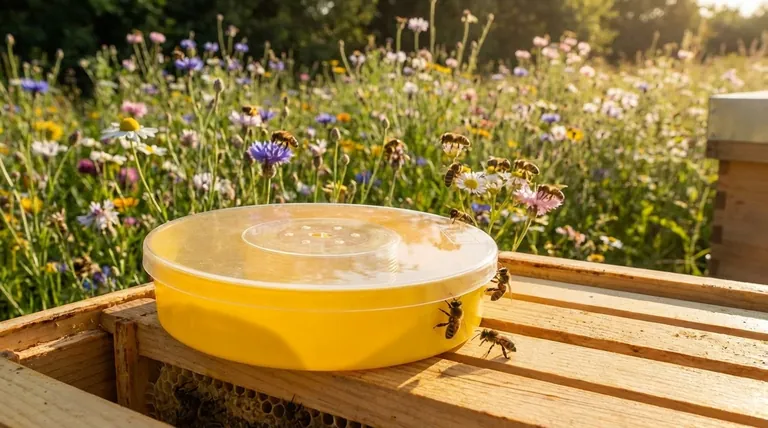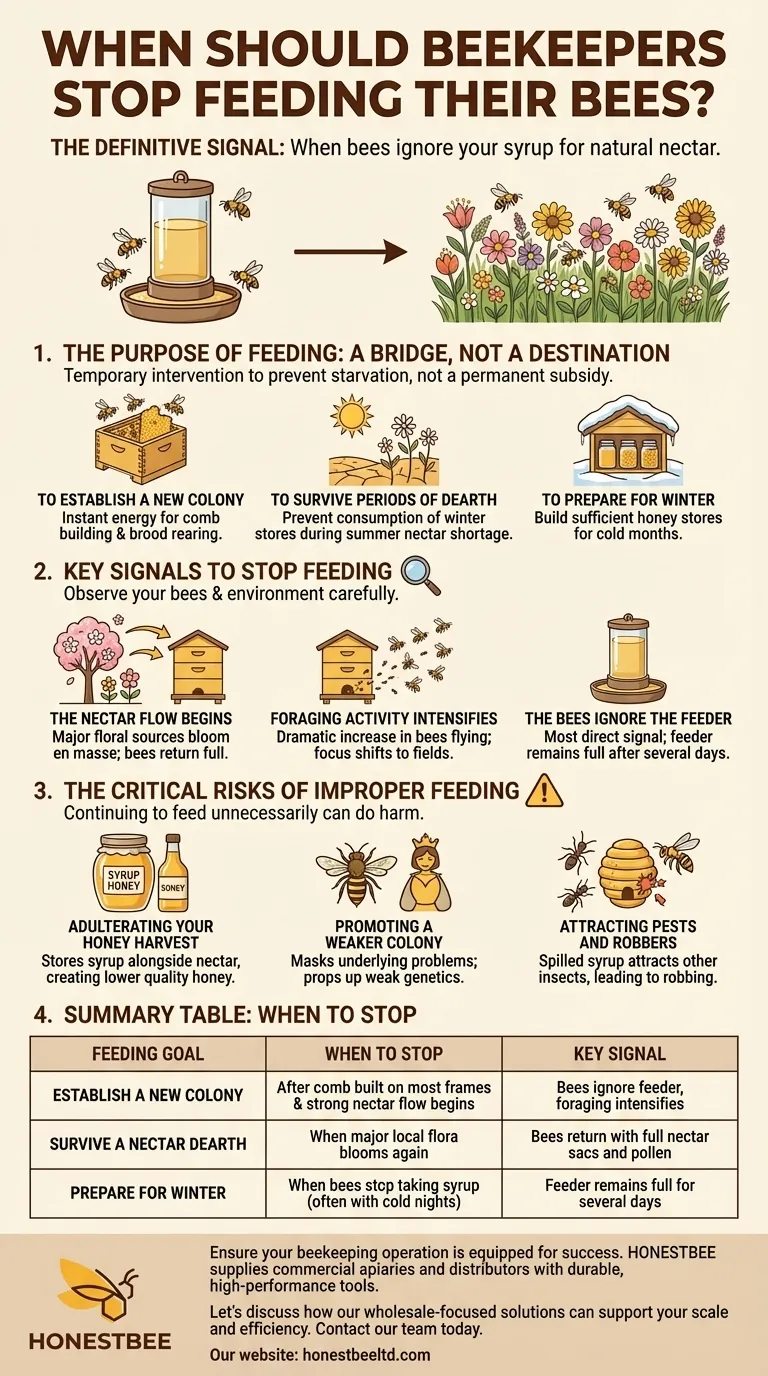The definitive signal to stop feeding your bees is when they tell you to. When a colony is established and natural nectar sources become plentiful, the bees will reduce or completely ignore the sugar syrup you provide, preferring the superior nutrition of real flowers.
Bee feeding is a temporary intervention designed to prevent starvation, not a permanent subsidy. The primary goal is to support a colony until it can sustain itself, ensuring the honey they produce is pure, natural, and not adulterated by artificial sugars.

The Purpose of Feeding: A Bridge, Not a Destination
Understanding why you are feeding is crucial to knowing when to stop. Feeding is a targeted tool used only in specific circumstances to ensure colony survival and health.
To Establish a New Colony
A newly installed package or nucleus hive has an enormous task: building wax comb, rearing brood, and gathering resources from a new environment. Feeding provides the instant energy they need to rapidly build their home.
To Survive Periods of Dearth
A "nectar dearth" is a period when few flowers are blooming, often during a hot, dry summer. Supplemental feeding during a dearth can prevent a colony from consuming all its winter stores just to survive the summer.
To Prepare for Winter
In late autumn, beekeepers feed heavy syrup to help the colony build sufficient honey stores for the long winter. This is especially critical in regions with harsh winters or if the summer harvest was weak.
Key Signals to Stop Feeding
Your bees and the environment will provide clear signs that it's time to remove the feeder. Your primary job is to observe carefully.
The Nectar Flow Begins
The most important signal is the start of a "nectar flow," a period when major floral sources bloom en masse. You will see bees returning to the hive with abdomens full of nectar and legs packed with pollen.
Foraging Activity Intensifies
A dramatic increase in the number of bees flying in and out of the hive is a clear indicator that they have found abundant natural food. Their focus shifts from your feeder to the fields and flowers.
The Bees Ignore the Feeder
This is the most direct signal. If you find the feeder is still full after several days or a week, the bees have found something better. They are voting with their wings; respect their choice and remove the feed.
The Critical Risks of Improper Feeding
Continuing to feed when it is not necessary can do more harm than good, undermining both the health of your colony and the quality of your honey.
Adulterating Your Honey Harvest
This is the most significant consequence. If you feed during a nectar flow, bees will store that sugar syrup in the honeycomb right alongside natural nectar. This adulterates the final product, creating "syrup honey" that lacks the complex flavors and beneficial properties of real honey.
Promoting a Weaker Colony
While intended to help, continuous feeding can mask underlying problems. It may prop up a colony with a weak queen or poor foraging genetics that would otherwise be replaced.
Attracting Pests and Robbers
Spilled syrup or external feeders can attract ants, wasps, and bees from other hives. This can lead to robbing, a scenario where a stronger hive attacks and steals the resources of a weaker one, often destroying it in the process.
How to Apply This to Your Hive
Your decision on when to stop feeding should be based on your specific goal and the colony's current condition.
- If you have just installed a new colony: Stop feeding once they have built out comb on most of the frames in their first hive box and you observe a strong, natural nectar flow has started.
- If you are supporting a hive through early spring: Stop feeding as soon as you see major local flora like fruit trees, dandelions, and maples begin to bloom.
- If you are preparing a hive for winter: Stop feeding when the bees no longer take the syrup, which often coincides with consistently cold nighttime temperatures.
Ultimately, your role is to provide support only when absolutely necessary, allowing your bees to be the resilient, self-sufficient foragers they are meant to be.
Summary Table:
| Feeding Goal | When to Stop | Key Signal |
|---|---|---|
| Establish a New Colony | After comb is built on most frames & a strong nectar flow begins | Bees ignore the feeder, foraging activity intensifies |
| Survive a Nectar Dearth | When major local flora blooms again | Bees return with full nectar sacs and pollen loads |
| Prepare for Winter | When bees stop taking syrup (often with cold nights) | Feeder remains full for several days |
Ensure your beekeeping operation is equipped for success. Proper feeding is just one part of effective hive management. HONESTBEE supplies commercial apiaries and beekeeping equipment distributors with the durable, high-performance tools needed for healthy, productive colonies—from feeders and hive tools to extractors and protective gear.
Let’s discuss how our wholesale-focused solutions can support your scale and efficiency. Contact our team today to explore our product catalog and pricing.
Visual Guide

Related Products
- HONESTBEE Round Hive Top Bee Feeder for Syrup
- Professional Hive Front Entrance Bee Feeder
- Classic Boardman Entrance Bee Feeder Hive Front Feeding Solution
- HONESTBEE Entrance Bee Feeder Professional Hive Nutrition Solution for Beekeeping
- Boardman Entrance Bee Feeder Durable Galvanized Steel and Wood Construction for Beekeeping
People Also Ask
- What safety features are included in top feeders? A Guide to Drowning Prevention and Hive Safety
- How do hive top feeders work? A Guide to Efficient, High-Capacity Bee Feeding
- What features make top feeders a reliable choice for beekeepers? A Guide to Safe, Efficient Hive Nutrition
- What types of hive boxes is the round hive top feeder compatible with? Universal Fit for 8 & 10-Frame Langstroth Hives
- What is the correct method for preparing sugar syrup for bees? Ensure Safe, Non-Toxic Feeding for Your Hives



















